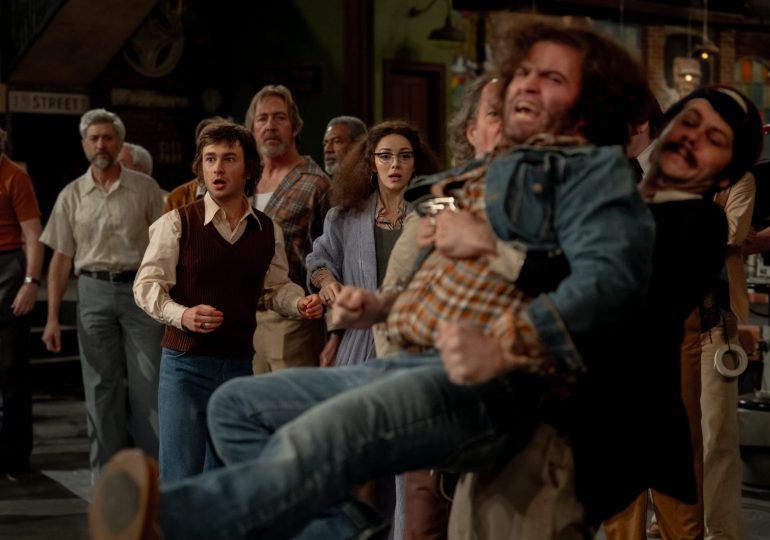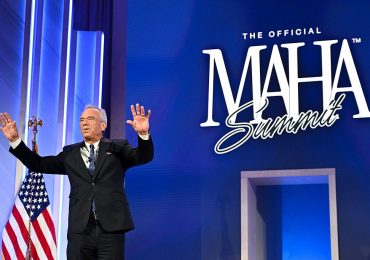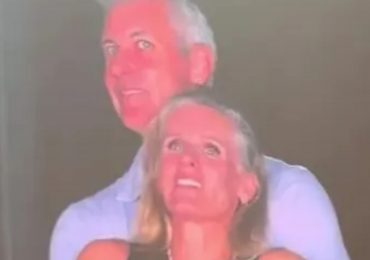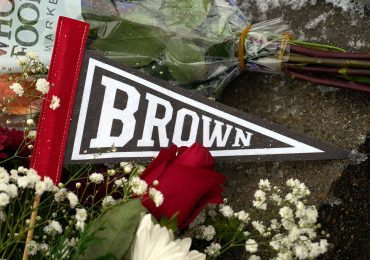Saturday Night, an uproarious account of the chaotic 90 minutes leading up to the first episode of Saturday Night Live, hits theaters nationwide on Oct. 11 in a nod to the air date of the first episode of the comedy series on Oct. 11, 1975, broadcast from NBC’s studio 8H. The film release coincides with the show’s 50th season which kicked off Sept. 28.
[time-brightcove not-tgx=”true”]
Just as the social movements of the 1960s were transforming every aspect of American life, the live comedy show was part of a revolution in television in the 1970s. But Saturday Night is more about recreating a feeling than recreating actual events. “The goal is to make you feel what it feels like when you’re on the ground in 8H moments before, how it feels like there’s no possible way the show is going to make it to air because everything’s happening so last second,” says Saturday Night director Jason Reitman. “They’re still painting the sets, hemming the clothes and the wigs—all of that is happening right up until the last second.”
The filmmakers (Reitman also co-wrote the screenplay, with Gil Kenan) interviewed everyone they could find who was on set for the premiere, including SNL creator and showrunner Lorne Michaels, actors, writers, people in the art department, and even former NBC pages. And while the movie may be more about capturing the spirit of the night than the exact events, many viewers may walk away with some questions about a llama, a fire, and an aggressive censor. For a look at what parts of the movie were based on truth or fiction, TIME talked to Reitman and James Andrew Miller, an author of Live from New York: The Complete Uncensored History of Saturday Night Live as Told by Its Stars, Writers, and Guests.
Read more: A Who’s Who of the Famous Faces in Saturday Night
How did Saturday Night Live come to be?
NBC was looking for something that could replace reruns of Johnny Carson’s late-night TV show, and Carson (played in the movie by Jeff Witzke) was all for the SNL experiment.
Lorne Michaels (Gabriel LaBelle), a Canadian TV writer, wanted to create a show for the generation that grew up with television, that represented their fashion sense, their tastes in music, their sense of humor. Reitman describes SNL as an “orphanage for a variety of performers and writers of all styles.” Case in point, the original cast was known as “The Not Ready for Prime Time Players,” and included: Dan Aykroyd (played by Dylan O’Brien), John Belushi (Matt Wood), Chevy Chase (Cory Michael Smith), Jane Curtin (Kim Matula), Gilda Radner (Ella Hunt), Garrett Morris (Lamorne Morris), and Laraine Newman (Emily Fairn).
Al Franken (Taylor Gray), one of the first SNL writers, recalls in Live from New York: “We wrote a perfect submission for Saturday Night Live, a package of things we’d like to see on TV—a news parody, commercial parody, and a couple sketches. Basically from that, we were hired.”
Saturday Night became Saturday Night Live in 1977.
Did Lorne Michaels really find an SNL writer at a bar?
Yes, as seen in Saturday Night, Alan Zweibel (Josh Brener) was discovered at a bar, though unlike in the movie it did not happen on the same night as the first show. Michaels hit up every kind of a nightclub looking for writers for SNL. According to Live from New York, Michaels went up to Zweibel at a bar and said, “You know, you’re the worst comedian I’ve ever seen in my life.” Zweibel said he wanted to have a wife and kids someday but they’d starve if he didn’t land a job soon. Michaels asked Zweibel if he could look at his notes, and they arranged to meet again to talk more. Zweibel went back to his home in Long Island that night and says he stayed up for two days straight typing up every good joke he ever came up with to present during his interview at the Plaza hotel.
Michaels asked him how much money he needed to live, and Zweibel told him it’d be great if he could match the $2.75 an hour he was making working at a deli. “But,” Zweibel recalls saying, “If there’s one f-cking mime on the show, I’m outta there.”
The first joke in the compendium Zweibel presented was the only joke Michaels read, about how a new postal stamp commemorating prostitution in the U.S. that costs a dime, but if the mailer wants to lick it, then it costs a quarter. Chevy Chase performed the joke on the inaugural Weekend Update.
Why didn’t John Belushi want to sign his contract?
In the movie, Belushi avoids signing his contract for as long as possible. In the minutes leading up to showtime, Michaels finds him ice skating on the rink at Rockefeller Center. It’s true that Belushi only signed his contract the day of the show. (Though it’s unlikely that he went ice skating.)
“Belushi went completely missing on that opening Saturday night,” says Reitman.
The actor had “nothing but disdain for television,” Miller says. “He thought it was an inferior art. He thought there was a lot of crap on TV.”
As Reitman explained his portrayal of Belushi, “I was deeply interested in Belushi’s vulnerability and fears about going on live television—how that would change his life and how that would define him from then on.”
Did the set really catch fire before the SNL premiere?
There wasn’t a fire. The set catching fire is a dramatization of several mishaps in the walk-up to the premiere. But there is a story in SNL lore about John Belushi accidentally setting Lorne Michaels’ mattress on fire. When Belushi’s fiancée Judith had kicked him out of the house after a fight, he went to stay with Michaels, and ended up falling asleep with a cigarette lit.
It is true, however, that on the SNL set, Michaels kept asking for more lights—which is what sparks the fire in the movie. As Reitman explains, “He wanted [the show] to be as good looking as any movie, and as a result, he just kept adding sets and camera cues and lighting and stuff that had never been done before.”
Were sketches still being planned up to the last minute?
Yes, the show was more than three hours long going into the dress rehearsal. In the movie, Michaels is getting the third degree from NBC executives who want to know what he’s going to cut—and also what the show is about in the first place. But Michaels never really gives them an answer. There’s a reason for that, says Miller: “There was a lot of craziness going on, but Lorne probably also didn’t want to have to be boxed in. He didn’t want to give them too much information. He wanted to have as much creative license as possible.”
How stoned was the host, George Carlin?
Carlin (Matthew Rhys) was loaded. All kinds of substances have fueled the SNL team over the years. It was apparently a miracle that he made it onto the stage in clothes at all. He put up a stink the night of the show because wanted to wear a t-shirt on air, but NBC wanted him to wear a suit. Because affiliates had not 100% signed on to broadcasting the show, the compromise was that Carlin would wear a suit and a t-shirt instead of a necktie. “That was a much greater distraction than can possibly be understood right now,” Michaels says in Live From New York.
Was Lorne Michaels supposed to host Weekend Update?
That was the plan. At one point in the dress rehearsal in the movie, he’s seen as stumbling through his lines, not in command of the material. In reality, he had to decide whether to be one of the actors or one of the producers. He was about the same age as the cast. Reitman describes the decision as, “‘Are you going to be one of the kids? Or are you going to be the Dad?”
But the role went to Chase. Reitman recalls Dave Tebet (Willem Dafoe), who ran talent for the network, immediately identifying Chase as a star. “Through Tebet’s eyes, Chevy represented the opportunity of Saturday Night Live,” as Reitman puts it. That’s why Chase’s character in the movie is so cocky. Herb Sargent (Tracy Letts), one of the early writers, recalls a more humble encounter in the minutes leading up to the first broadcast, as Chase said to him, “‘What’s going to happen to me? Where am I going to go from here?” Sargent said, “You’ll probably end up hosting a talk show.”
Why is a llama backstage at SNL?
The llama in the film is supposed to represent showrunners’ decision early on that, as a running joke, any time cameras went backstage, the audience would see a live llama, a showgirl, and a guy dressed as Abraham Lincoln. The joke has been a tradition for the last 50 years.
Who is the woman representing the NBC standards department?
Reitman says the character, played by Catherine Curtin, is a composite, based on several women who did the job of making sure nothing X-rated would be broadcast to NBC’s family-friendly audience. Per the movie, there really was a woman in NBC’s standards department who asked what a golden shower is. “Multiple people told me about trying to hide things in the script to see what she would notice,” says Reitman.
Were there really bricklayers on the set of the premiere?
Yes, they laid the bricks in the shape of a home base (as in baseball), and it was supposed to represent a street corner in NYC. “If you were watching from anywhere in America, you would see home base and feel like you were being teleported to a gritty New York street.”
The image of people literally laying bricks is a metaphor for how groundbreaking the show was. Reitman says: “Lorne approached every part of making a television show as though it never had to be done that way, like laying brick, which is something that no one would ever do on a TV show.”
Leave a comment









